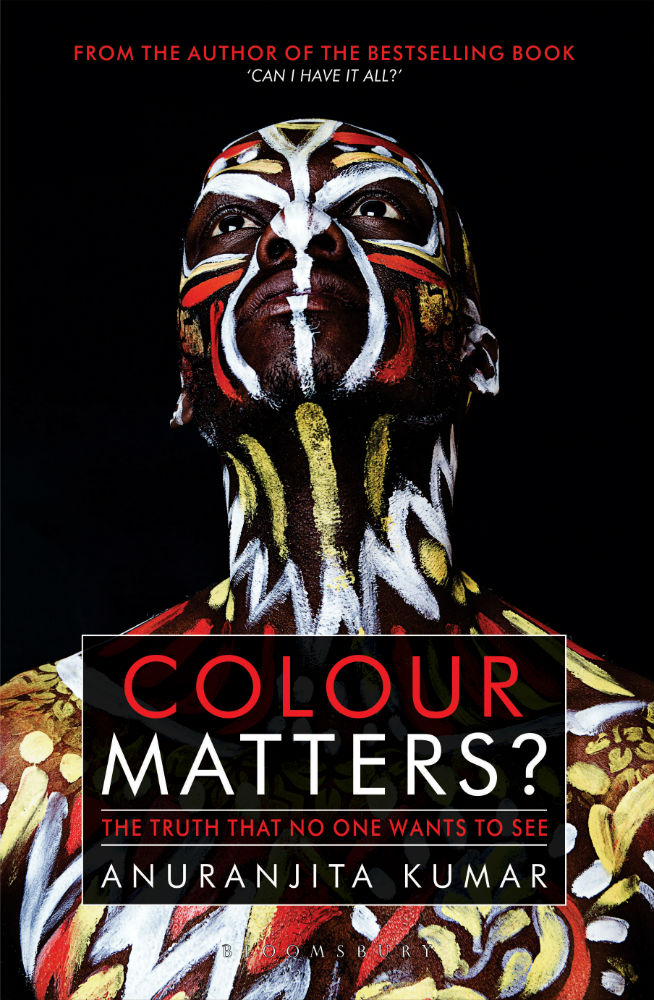According to author and diversity equality campaigner Anuranjita Kumar, there is still a social taboo when it comes to discussing racism openly within the workplace, and wider society.
This is something she is hoping to change with her latest book, Colour Matters? The Truth That No One Wants To See, which draws upon her own experiences of prejudice as a woman of colour as well as those of minority professionals from around the world.
We speak exclusively with Anuranjita, the Managing Director and Head of HR – Hubs at the Royal Bank of Scotland, about what drives racism and how it can be countered to move towards a colourless future.

How does the colour of skin affect how a person is perceived? Why do you think these attitudes arise?
Perceptions and biases are subjective feelings and thoughts based on the limited information and experiences each of us has. However, these perceptions – even if they are distorted – guide our reality, which in turn guides our reactions. As multiple studies have shown, different skin tones are associated with different ideas. Black, for instance, is often associated with fear or mystery; white with purity; and brown with poverty and impurity. Sadly, these impressions are often carried to those who perceive racial superiority and inferiority.
These attitudes arise because of our early experiences within our family, our social circles, the media and the distorted realities that have been handed down over generations that become so-called gospels of truths. They become unconscious biases as there is enough legitimacy given to these by what we see and hear. None of us are free of these biases and it is unrealistic to say that we are evolved enough to stay away from all levels of biases. For too long this has driven our behaviour, economics and social access, and the baton continues to be passed to future generations in the same way.
The colour of a person’s skin is the first visual clue we receive and has a huge impact on the reactions that follow. In those first few minutes views are formed and the only way that these can be overcome by reality is through engaged conversations or deeper relationships. Unfortunately, not many people have the time to do that. But to be watchful and to be guarded against these biases, especially when you hold key positions and are taking key decisions at home or at workplace, is important.
Operating with some preconceptions on what people and certain groups may be like is appropriate. Rigid views and reactions defined by colour or physicality without any experience with those people, however, often lead to undesired outcomes or relationship breakdowns.
To ensure we are on the right path, it is important that we explore our motives, thoughts and views when we meet new people. For me, when I meet someone new, my questions are usually open ended. For instance, “What do you enjoy or prefer to do in your time?”; “Where do you get your mojo from?”; and “What drives you?”. That is more important than asking where someone come from, what their religion is, or ethnic background.
As a woman of colour, when did you first become aware of this, and how did it affect you?
Life is about choices that finally define us. However, no one chooses their colour, ethnicity or race. It is a given and the world tends to define us by that irrespective of what lies beneath. Having worked across multiple continents in my career, which has spanned over 24 years, there are several instances, experiences and learnings that have unfolded in my path. There were times I felt elated, other times isolated and then vindicated. As I engaged with colleagues, friends, mentors and support networks all around the world, I found that I was not alone in this journey and there were others who were caught up in the same maze. It led to my quest of sharing these learnings with many out there who may benefit from these experiences.
In my experience I found skin colour to be a hinderance in Europe. Amongst the largely white populaces I felt prejudged, cornered, and frustrated. I am brown and my mannerisms were different, my English was Asian, my hair was black, but my heart was pure and pristine white. However, I was sometimes not judged on my intent but challenged on my motivation for being different. I was different, but not wrong and that gave me the courage to remain resilient.
Working across continents, I have always found myself being able to somehow stand my ground and push back. Not without any consequences, but that’s a choice I took earlier on in my career. I have won many friends and encountered unpleasant experiences too, but it helps to sometimes acknowledge, accept and then take the right steps.
You have enjoyed a highly successful career in human resources, but how have you had to fight against racist attitudes within the corporate world to get where you are today?
Well, some of those experiences I have written about in my book. In a corporate culture we often endure much, simply to avoid confrontation. We start telling ourselves that there must have been some misunderstanding while, in reality, the latter may be true. Soon, this becomes the new normal for people to deal with us and for us to accept from them. So, ideally, what I tell the scores of individuals I mentor is, there is never a rationalisation of tolerance or endurance in the face of prejudice – it should ideally be zero tolerance. You should be valued for who you are and what you bring to the table, and what additional value you create. Your ethnicity and colour of skin should have no bearing on any of these. The other side to this is that you also need to be accepting of others. While you push yourself out there, you should also be open to accepting people on a neutral platform and not react to others as if they are superior or inferior to you.
Usually, topics like ethnicity and racism have been ignored in daily lives or are uncomfortable to acknowledge, let alone discuss openly, thereby legitimising such behaviour both for the oppressor and the oppressed. Further, I have found very few experience-based learnings that have been directed towards collectively working to find a solution I wanted to make a humble attempt to enable us to at least share thoughts and invite reactions through the book. Colour of the skin offers us a coloured view of the world around us; and it is important to step outside these biases into the real world out there.

You say in Colour Matters? that racism is still something that people shy away from discussing openly. Why do you think this is?
Racism is a recognised social problem but, unfortunately, though we may like to think otherwise, not too many people realise it as a ‘problem’ and that usually is the biggest issue.
Some organisations are afraid to openly acknowledge or deal with this debate due to the shame and embarrassment it carries with it. The journey towards openly dealing with racism, then, starts with ourselves, even before we bring it to the workplace. When I say ‘ourselves’, I refer to those little interactions with others that take place such as with a shopkeeper who think he is superior to me because our different skin colours. Such notions are all fictions of the mind. We often are ignorant and hence encourage wrong attitudes and prejudices. It’s time that we realised when to draw a line and then stick with it.
In your book you use the acronym ‘COLOUR’ to set out how a society can become more tolerant and accepting of diversity. How would you sum this up to readers…
Colour Matters? is basically a minority’s perspective on colour and ethnicity while they are dealing with a situation where the majority is of a different colour, which may be brown, white or black depending on the nation. To begin with, I encountered a push back against the concept of my book, even from my closest friends. Even some of the leading publishers, surprisingly, asked me if bias on the basis of skin colour was actually an issue in today’s world. Luckily, my organisation was supportive and asked me to go ahead with the book.
It was then about filtering the stories I gathered from minorities and arranging them. I used the word ‘COLOUR’ as a fitting way of achieving this, standing for Connect, Openness, Love, Objectivity, Unbiasedness and Resilience, and bunching up the experiences under these themes so they could offer a workable roadmap for my readers.
Based on your research, is racism still rife within the corporate world? If so, how should this be addressed to bring about greater diversity?
Only one in every 16 companies in the FTSE 100 currently have a person of colour at the top, and unless we consciously strive and work towards changing attitudes, these numbers are not going to get better.
We have to begin by acknowledging that we have a problem. I firmly believe that we do not see this as a serious enough issue. To bring about a change across all levels of the corporate world there has to be a strong, pro-diversity messaging coming from the top.

Do you believe that society’s attitudes towards mixed-race relationships has progressed within the last few decades?
One might think that with the dawn of the digital age, and the way media today portrays mixed couples, things should have moved on. But I still have friends who acknowledge that their children still get a ‘stare’ when they are out in a restaurant. That is when you go back to the same media I am referring to and scan the number of movies that portray mixed couples as ‘normal’ – I’m sure you’d count them on your fingers. The same can be said of the traditional approach we have noticed from musicians, fashion labels and our educational institutions and corporates. All of these are formed by individuals and unless we change our attitude and find a ‘new normal’ inside our heads, the society around us will never experience a real change.
Based on your research, what advice would you give to couples in a mixed-race relationship?
Mixed-race relationship has usually crossed the hurdle of colour barriers and that, in itself, is a big win. That connect provides both partners the courage to deal with the world around them as love transcends all boundaries.
My advice would be:
- Talk and communicate freely to each other, especially about your race, as it is a long discovery process - more so if you are from different backgrounds. This keeps the relationship strong. Don't assume.
- Keep yourself open-minded to each family challenge that come your way and hold judgements while in the discovery process.
- Do not let one race accidently dominate the other in the relationship. Talk about your own systems of values, drivers, and goals.
- Mix your individual cultural values and drivers and make a new one that is your own. You could take the best parts of two different ethnicities and make a richer legacy for the next generation.
- Focus on similarities while understanding the differences. Especially in case of different religions, being tolerant and appreciative of each other’s belief will bring rich diversity to your shared life journey.
In our family we celebrate festivals of many different faiths - Diwali, Christmas, Hanukah and Eid - as my children have friends who belong to different ethnicities (and it is another reason for them to get gifts every second month!).
Similarly, what advice would you give to BAME professionals looking to progress their careers?
I would advise people to believe in themselves, push back when needed, pull back when appropriate, find supporters and not to be afraid to ask for what you truly deserve. It is important to sometimes raise your voice and challenge others. Play on your strengths and adapt to the context and environment without compromising your self-respect.
In my journey, I won some battles and I lost some, while contending with skin colour on occasion that left me fighting not for further advancement but merely to salvage my respect and dignity. I remember in my earlier days, there were assumptions made whether I walked into meetings or pushed the boundaries of my ambition, or simply entered a supermarket, as people were not familiar with Asian mannerisms. However, we cannot generalise that all those around us are ignorant. I have made many friends across different ethnicities, who helped me out in new countries. These experiences propelled me to look at life differently.
There is always a learning and an opportunity to share and embrace the unknown. Often a person’s background, their life struggles, and goals play a crucial piece in carving out that journey. It is these learnings that I trust will, in some way, offer an insight to others on identifying biases that often go unnoticed and behaviour that needs correction, as well as recognising the moments when one needs to step above these biases to see the world differently.
Overall, based on your research, do you think the world is moving in the right direction when it comes to stamping out racism? Do you envisage a time in the future when the colour of a person’s skin will no longer be an issue?
Accept there is a problem and embrace it all out!
I am a huge believer of talent, merit and inclusion and I think, as practitioners, we should encourage and go about it in a targeted way. One of the examples I cite in my book is diverse panels and the number of hires that we make. We talk about diversity, but how are we really holding panels accountable? Because of what happens in the interview room, and the biases that are in play, we may get a diverse set of candidates but they will never make it through the recruitment process unless there is fairness.
Now how do you ensure this ‘fair play’? These are very difficult questions to find answers to, which is why I keep reiterating that they require efforts at all levels within a company. There must be a strategy around how we hire talent, how we develop them and how we promote them. But it all starts with the mindset and culture.
Colour Matters? The Truth That No One Wants To See (Bloomsbury) is available now on Amazon, priced £12.99 in paperback and £8.60 as an eBook. Visit www.colourmatters.in

